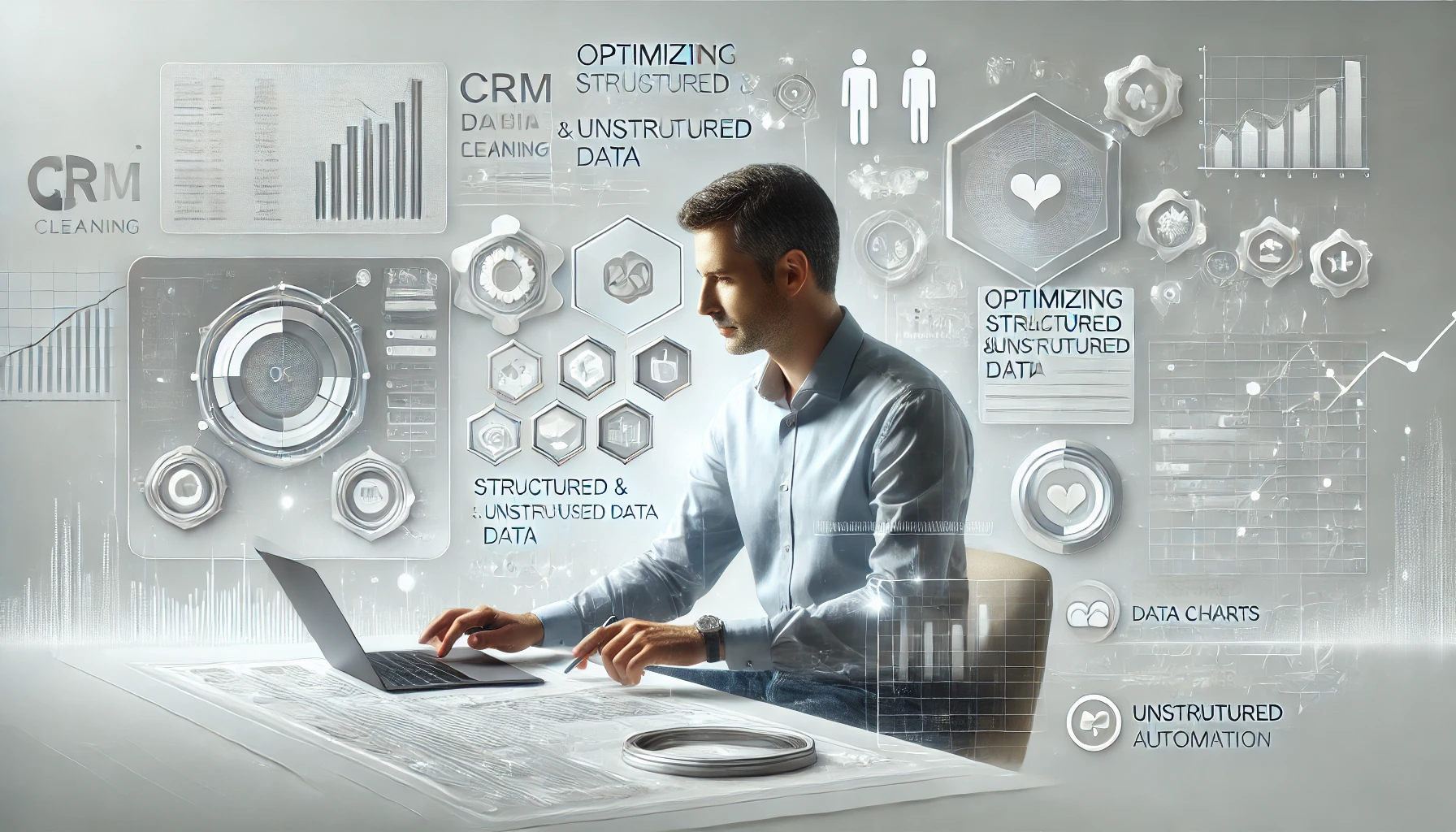When it comes to optimizing your CRM data cleaning process with consultants, you might be surprised at the impactful insights they can bring to the table. By tapping into their expertise, you can uncover hidden efficiencies and revamp your current procedures for better results. With a tailored approach and strategic guidance, consultants can help you pave the way for a more streamlined and efficient data cleaning process. Let’s explore how this collaborative effort can transform your CRM data management practices.
Understand Current Data Cleaning Process
To effectively streamline your CRM data cleaning process, the initial step is to thoroughly understand your current data cleaning procedures. Begin by conducting a comprehensive data analysis to identify the areas that require attention. This involves scrutinizing the quality of your data, identifying duplicate entries, and assessing the accuracy of the information within your CRM system. System integration plays a crucial role in this process, as it ensures that all data sources are aligned and synchronized, facilitating a seamless data cleaning operation.
Discuss With CRM Consultants
Engage in meaningful discussions with experienced CRM consultants to gain valuable insights into optimizing your data cleaning process. By collaborating with consultants, you can leverage their expertise in data analysis to identify areas for improvement within your current data cleaning process. During these discussions, make sure to provide a detailed overview of your existing procedures and share any challenges you are facing. This will enable the consultants to offer tailored advice and strategies to streamline your data cleaning efforts effectively.
Consultation feedback from CRM experts can provide you with a fresh perspective on your data cleaning process, highlighting potential inefficiencies and offering innovative solutions. Through these discussions, you can also learn about best practices and industry benchmarks to enhance the overall quality of your CRM data. Additionally, consultants can assist you in developing a roadmap for implementing changes based on their feedback, ensuring a structured approach to optimizing your data cleaning process. Collaborating with CRM consultants can ultimately lead to more efficient data management practices and improved decision-making capabilities for your organization.
Identify Areas for Improvement
After discussing your data cleaning process with CRM consultants and gaining valuable insights, the next step is to pinpoint specific areas for improvement. Conduct a thorough data analysis to identify bottlenecks or inefficiencies in your current CRM data cleaning process. Look for patterns of data duplication, inaccuracies, or outdated information that may be causing delays or errors. Assess the effectiveness of your current tools and technologies in handling data cleaning tasks efficiently.
Consider streamlining data entry processes to minimize manual errors and reduce the time spent on repetitive tasks. Evaluate the integration between different systems to ensure seamless data flow and consistency across platforms. Additionally, analyze the training and support provided to employees involved in the data cleaning process to enhance their efficiency and effectiveness.
Develop Streamlined Process Plan
To develop a streamlined process plan for CRM data cleaning, you should start by creating process maps to visualize the steps involved and identify areas for optimization. Clearly defining roles and responsibilities within the data cleaning process will help streamline communication and ensure accountability. Incorporating automation tools where possible can significantly increase efficiency and accuracy in managing CRM data.
Process Mapping for Efficiency
To enhance the efficiency of your CRM data cleaning process, it is crucial to develop a streamlined process plan through process mapping. Efficiency mapping and consultant collaboration are key elements in this endeavor. Here are four essential steps to effectively map out your CRM data cleaning process:
- Identify Current Workflow: Begin by documenting your current data cleaning workflow to understand the existing process thoroughly.
- Analyze Pain Points: Evaluate the bottlenecks and inefficiencies in your current process to pinpoint areas that require improvement.
- Design Optimized Process: Utilize the insights gained from analyzing the current workflow to design a more streamlined and efficient data cleaning process.
- Implement Changes: Once the optimized process is finalized, implement the necessary changes and ensure that all team members are trained on the new process for seamless adoption.
Define Clear Roles
In streamlining your CRM data cleaning process, a pivotal aspect to focus on is defining clear roles within your team. Role clarity is essential for ensuring that each team member understands their responsibilities and how they contribute to the overall data cleaning process. By clearly defining roles, you can avoid duplication of efforts, reduce confusion, and improve efficiency.
To achieve role clarity, start by outlining specific tasks and responsibilities for each team member involved in the data cleaning process. Ensure that these roles are well-understood and agreed upon by all team members. This will help in team alignment, where everyone is on the same page regarding their duties and expectations.
Team alignment is crucial for a smooth data cleaning operation, as it fosters collaboration and coordination among team members. When roles are clear, individuals can work together more effectively, leveraging each other’s strengths to achieve the common goal of cleaning and maintaining high-quality CRM data. By defining clear roles and promoting team alignment, you can streamline your CRM data cleaning process and enhance overall productivity.
Implement Automation Tools
Implementing automation tools is a critical step in developing a streamlined process plan for your CRM data cleaning. By incorporating automation benefits into your data cleaning process, you can significantly enhance data accuracy and efficiency. Here are a few key points to consider:
- Time Efficiency: Automation tools can perform repetitive tasks much faster than manual methods, saving you valuable time.
- Consistency: Automation ensures that data cleaning processes are carried out consistently, reducing the risk of human error.
- Scalability: As your business grows, automation tools can easily scale to handle larger volumes of data without compromising accuracy.
- Integration: Automation tools can seamlessly integrate with your CRM system, allowing for smooth data cleaning processes and accurate updates.
Train Team on New Process
When introducing a new process to your team, ensuring they are properly trained is crucial for successful implementation. Team training is essential to guarantee that everyone understands the new process and can execute it efficiently. To optimize process efficiency, consider conducting comprehensive training sessions that cover all aspects of the new process. Start by outlining the objectives and benefits of the new process to create buy-in from your team. Provide detailed instructions on how to execute each step, using real-life examples or simulations to reinforce learning. Encourage open communication and address any questions or concerns that team members may have during the training sessions. Consider assigning mentors or creating job aids to support employees as they transition to the new process. Regularly assess the team’s progress and provide feedback to ensure they are confident in applying the new process effectively. Remember, a well-trained team is the key to successfully streamlining your CRM data cleaning process.
Implement and Monitor New Process
To ensure the successful execution of the new CRM data cleaning process within your team, the next crucial step involves implementing and closely monitoring its adoption. Here are key actions to take:
- Establish Clear Guidelines: Clearly outline the steps and expectations of the new process to ensure uniform understanding and implementation.
- Provide Ongoing Training: Continuously train team members on the process to maintain consistency and address any emerging challenges effectively.
- Implement Performance Tracking Tools: Utilize software or tools to track the performance of the data cleaning process, allowing for real-time monitoring and adjustments.
- Conduct Regular Data Analysis: Perform regular data analysis to assess the effectiveness of the new process, identify areas of improvement, and make data-driven decisions for optimization.
Evaluate and Adjust for Efficiency
To ensure the success of your CRM data cleaning process, it is crucial to assess its effectiveness thoroughly. By evaluating the current process, you can identify areas that require adjustments and make necessary changes promptly. This iterative approach allows you to continuously optimize the process for maximum efficiency and effectiveness.
Assess Process Effectiveness
For assessing the effectiveness of your CRM data cleaning process, it is crucial to establish clear metrics and benchmarks to evaluate its efficiency. To ensure that your process is delivering the desired results, consider the following steps:
- Data Quality Metrics: Define specific measurements for data accuracy, completeness, consistency, and timeliness to gauge the overall quality of your CRM data.
- Process Evaluation Criteria: Establish criteria to assess the efficiency of each stage in the data cleaning process, including data collection, validation, transformation, and loading.
- Comparison with Industry Standards: Compare your data quality and process efficiency metrics with industry benchmarks to identify areas where improvements can be made.
- Feedback from Users: Gather feedback from end-users of the CRM system to understand their experience with the data and identify potential pain points or areas for enhancement.
Make Necessary Changes
In optimizing your CRM data cleaning process for efficiency, it is imperative to systematically evaluate its performance and make necessary adjustments. Start by focusing on data validation to ensure the accuracy and consistency of your information. This step involves verifying that the data is correct, complete, and relevant. By implementing automated validation checks, you can catch errors early on and prevent them from impacting your overall data quality.
Furthermore, consider incorporating data enrichment techniques to enhance the value of your CRM data. Data enrichment involves supplementing your existing data with additional information from external sources. This could include updating outdated records, filling in missing details, or appending new data points to enrich your customer profiles. By enriching your data, you can gain deeper insights into your customers, personalize your interactions, and improve the overall effectiveness of your CRM system.
Optimize for Efficiency
With the goal of enhancing the efficiency of your CRM data cleaning process, the key step is to evaluate and adjust for optimal performance. To optimize for efficiency, consider the following:
- Implement Data Automation: Integrate automated processes to handle routine tasks, such as data entry and validation, reducing manual efforts and minimizing errors.
- Conduct Team Training: Provide comprehensive training sessions for your team to ensure they are proficient in using CRM tools effectively and following standardized data cleaning procedures.
- Regular Performance Assessments: Continuously monitor the data cleaning process, identify bottlenecks, and implement necessary adjustments to streamline operations.
- Utilize Analytics Tools: Employ analytics tools to track key performance indicators and metrics related to data cleaning, enabling data-driven decisions for process enhancements.
Frequently Asked Questions
How Can We Ensure Data Security During the Cleaning Process?
To ensure data security during cleaning, implement data encryption and access control. Encrypt sensitive info and limit who can edit or view it. Use access logs to track changes. This approach adds layers of protection.
What Qualifications Should We Look for in CRM Consultants?
When selecting CRM consultants, focus on their industry experience and training programs. Look for candidates with a proven track record in your sector and those who have undergone relevant training to ensure they are up-to-date with best practices.
How Long Does It Typically Take to See Results From a New Process Plan?
Typically, it can take a few weeks to a few months to see measurable progress from a new process plan. Setting realistic expectations, tracking success, and adjusting strategies as needed will help streamline the timeline for effective results.
What Tools or Software Are Recommended for Streamlining Data Cleaning?
When tackling data analysis, think of your tools as a Swiss Army knife – versatile and efficient. Utilize automation tools like Salesforce Data Loader and Talend to streamline data cleaning. They offer precision and speed in managing your CRM data.
How Often Should the New Process Be Reviewed for Effectiveness?
For optimal efficiency, continuously monitor the new process. Regularly review its effectiveness through timeframe analysis. Make adjustments as needed to ensure ongoing improvements. This approach ensures that your data cleaning process remains effective and up-to-date.




